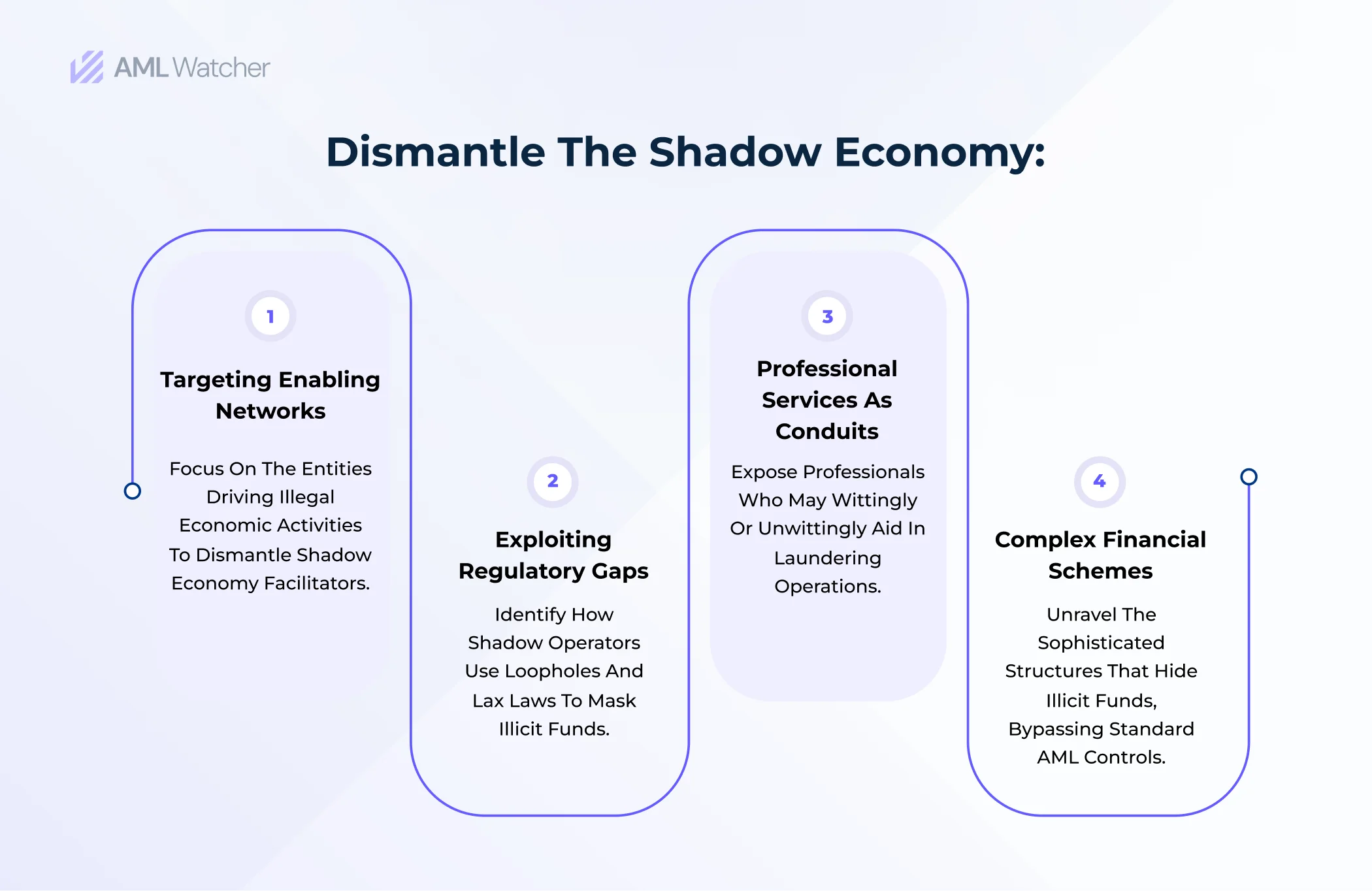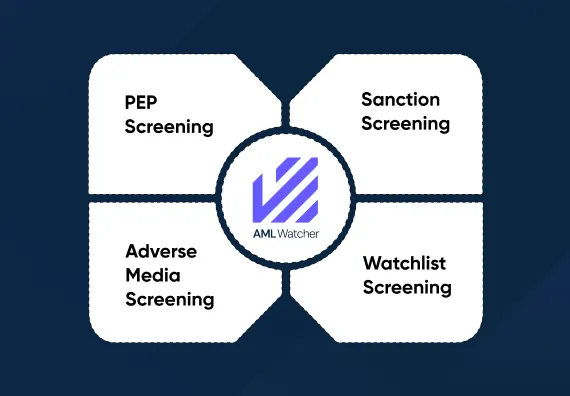
Shadow Economy: Its Size, Effects, and AML Tactics
The shadow economy is like some kind of riddle tucked away in the global financial system that is outside the purview of traditional regulatory supervision. It functions outside the bounds of conventional trade, that is largely obscured but yet essential to the overall economic picture.
The shadow economy and its complex relationships with the anti-money laundering (AML) regulations governing legal financial institutions are crucial. The IMF’s assessment of the shadow economy shows that it averages 31.9% of GDP across 158 countries from 1991 to 2015. This depicts a high level of informal activity that complicates the enforcement of AML regulations, as large portions of financial transactions occur outside the regulated banking system. This makes the investigation of this underground market essential for both its practical applications in improving AML procedures and its inherent intellectual merit.
The shadow economy is a complicated and frequently hidden phenomenon with many facets. It includes a broad range of actions that are outside the scope of official economic monitoring and governmental oversight. Let us dissect these nuances.
The Complex Side of Shadow Economy:
Concealed Income
Unreported income is the most prevalent part of shadow income as it comprises a lot of earnings from products that are not reported to taxation authorities.
According to research, 18-19% of all the revenue of the USA is not reported to government bodies, underlining a problem in assuring the reliability of governmental data. The situation also depicts a concealed amount of transactions that are processed on average.
Underground Markets:
Unreported income alone isn’t enough, underground markets, are another major component of the shadow economy. As per the IMF, Australia and Switzerland show lower rates of shadow income from 8-9% of the GDP, however, states like Zimbabwe and Bolivia reported 60% of GDP coming from the shadow economy. Picture now, the significant influence of black markets on the overall economy of a state.
Prohibited Employment:
Hiring people without appropriate paperwork is another part of the shadow economy. This gives leverage to people who want to evade taxes, social security, and employment protocols. This is known as “under the table” labor, which supports earning without being notified in paperwork.
Schneider and Enste’s research reveals that up to 80% of the official labor force may be employed in informal jobs in many countries including Gambia,
Barter & Self-sufficiency
Situations where products and services are traded without cash are a subset of the shadow economy. Such as facing international sanctions, Iran used the barter approach to the system to evade restrictions and traded oil directly for essential goods and services with countries like Russia, China, and India.
Traditional economic assessment methodologies face substantial problems due to the covert nature of these operations. These transactions are hard to track down and measure since they don’t go through regulated banks, show up in tax returns, or aren’t recorded in any official capacity. To estimate the size and scope of the shadow economy, economists and policymakers use indirect methods such as currency demand approaches or patterns of power usage. A variety of social and economic data are used using modeling techniques such as the Multiple Indicators Multiple Causes (MIMIC) method to assess the extent of the shadow economy. A number of variable factors that are suggestive of shadow economy activities are needed for this method.
Conventional wisdom in anti-money laundering (AML) efforts relies heavily on formal financial systems to track and flag suspicious activities, with a focus on large transactions that may signify money laundering. However, when it comes to combating the shadow economy, these traditional methods may fall short for several reasons. Let’s study those.
AML in the Shadows: Countermeasures Beyond the Obvious:
Due to their narrow visibility, traditional AML systems, which concentrate on official banking transactions, frequently overlook the cash or informal channel activity of the shadow economy. Up to $2 trillion is reportedly laundered annually worldwide, according to UN estimates, with 90% of money laundering activities remaining unreported. This figure highlights the shortcomings of conventional AML systems, particularly with regard to monitoring the unofficial or cash-based transactions that are a part of the shadow economy. Moreover, the inflexible, rule-based structures of these approaches are unable to keep up with the flexible strategies employed by shadow operators, who are always coming up with new methods to evade detection that don’t fit known suspicious patterns. The 1MDB crisis, which featured prominent political individuals and demonstrated the complex money laundering networks that conventional AML battles with, forced AmBank to pay a $700 million settlement. Furthermore, the efficacy of AML is undermined by its dependence on self-reporting; companies deeply ingrained in the shadow economy generally violate these laws, making self-reporting a mostly pointless exercise.
To address these shortcomings, innovative AML strategies are being developed and implemented:
- AML specialists are increasingly using innovative technology and algorithms to examine a variety of data sources—rather than simple traditional banking records—in order to identify trends that could indicate illegal activity in order to combat the shadow economy. The global cost of financial crime compliance has exceeded $274 billion in 2022, up from $213.9 billion in 2020. Costs are likely to rise further until 2023, demonstrating the incorporation of advanced technology and algorithms for AML purposes. This investment is motivated by the need to strengthen defenses against more complex financial crimes.
- By utilizing big data and behavioral analytics, they are able to identify concealed transactions and examine shifts in behavior that may indicate unapproved transactions. Big data has the ability to significantly transform AML operations, as evidenced by the staggering surge in data creation (1.7 gigabytes per person every second), which offers an abundance of analytical data.
- Working with fintech businesses enhances this endeavor even further by offering innovative tools for monitoring financial movements.
- To successfully monitor and fight the shadow economy’s worldwide spread, it is imperative to fortify public-private partnerships and foster international collaboration. These measures will facilitate information exchange and collaborative efforts.
Knowing about the ones who act as the perpetrators in the shadow economy is important. Let’s understand who enables it.
Unmasking the Enablers:
By concentrating on the networks, intermediates, and facilitators that serve as the wheels that propel illegal economic activity, it is possible to expose the people and organizations who are enabling the shadow economy. In order to conceal the source of illegal funds, these organizations and people exploit regulatory loopholes, take advantage of countries with laxer AML laws, and employ complex techniques like shell corporations, trusts, and layered financial transactions. They frequently use professional services, including those offered by some attorneys, accountants, and financial consultants, who may unintentionally or intentionally help in money laundering operations, and rely on the intricacy of international financial networks to move money covertly. Professional services and complicated financial structures are utilized by intermediaries in the shadow economy and money laundering schemes to conceal illegal cash. For instance, by utilizing their knowledge to hide illicit activity, financial intermediaries like bankers and lawyers have contributed to the yearly laundering of $2 to $3.6 trillion in Nigeria. They are able to evade the regular AML procedures by doing this, which are usually intended to identify simpler, less complex forms of money laundering.
Now that we know about the ones who play a role in advancing the shadow economy, learning about its future prospects is equally important.
The Future of Shadows: Prospects and Pitfalls:
AML tactics must simultaneously adjust to emerging technologies and shifting regulatory landscapes as the shadow economy develops. New channels for untraceable transactions are provided by emerging technologies like cryptocurrencies and decentralized finance platforms, which have the potential to grow the shadow economy. An extract from Chainalysis’ 2021 study states that 2.1% of all bitcoin transactions in 2019 were related to illegal behavior (approximately $21.4 billion worth of transfers). AML strategies need to stay up with the times by utilizing more complex data analysis methods, such as artificial intelligence and machine learning, to identify trends that point to illegal activity. Global regulatory agencies may simultaneously move towards more stringent regulations and more financial transaction transparency. The UN stresses enough about challenges linked with money laundering which fortifies the nature of crime, calling for major revisions in AML/KYC laws.
Suggested Read: The Long River Syndicate: Australia’s $144 Million Operation
Wrapping Up:
The shadow economy represents a labyrinthine network of unregulated economic activity that forms a significant portion of global GDP, challenging the enforcement of anti-money laundering (AML) regulations. It spans unreported income, complex underground markets, illegal employment, and non-monetary exchanges like barter. The traditional AML systems, designed to monitor formal financial transactions, often overlook the cash-based and informal transactions characteristic of the shadow economy. To counteract this, AML specialists are integrating advanced technologies and data analytics into their practices. There is a pressing need for a proactive and innovative approach to AML that not only embraces technological advancements but also upholds ethical standards in combating the shadow economy. This involves utilizing big data, strengthening public-private partnerships, and rigorously targeting the enablers who exploit loopholes for illicit activities. As shadow economic activities increasingly migrate to new platforms like cryptocurrencies, AML Watcher is proactively adapting, maintaining a delicate balance between innovation and ethical responsibility to effectively curtail these clandestine economic forces.
Contact us today to get a creative approach to AML that defends ethical standards in the fight against the shadow economy while also embracing technology breakthroughs.
We are here to consult you
Switch to AML Watcher today and reduce your current AML cost by 50% - no questions asked.
- Find right product and pricing for your business
- Get your current solution provider audit & minimise your changeover risk
- Gain expert insights with quick response time to your queries




